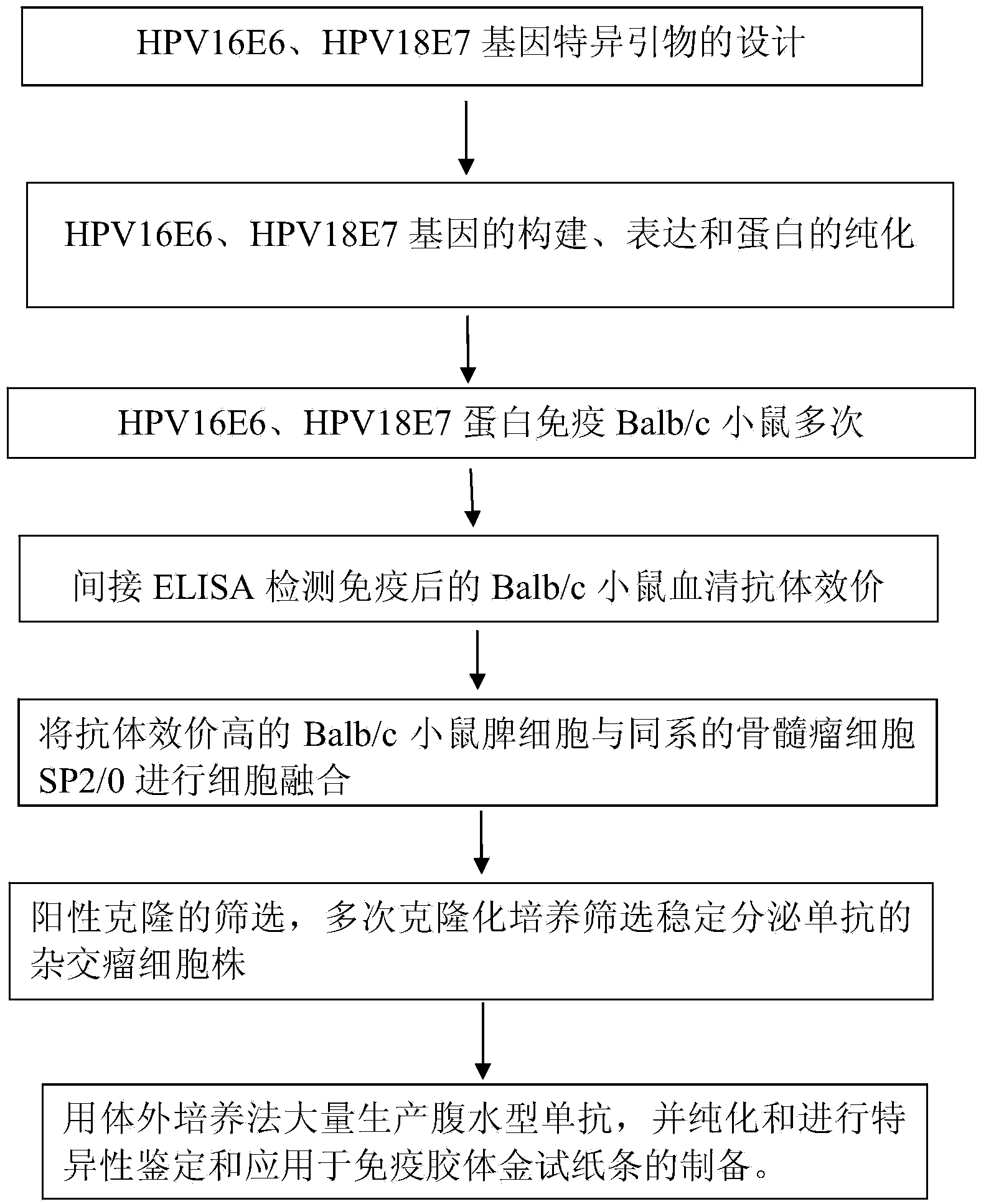Monoclonal antibodies for resisting high-risk human papillomavirus proteins and application of monoclonal antibodies
A technology of human papillomavirus and monoclonal antibody, which is applied in the direction of antiviral immunoglobulin, microbial-based methods, and the use of vectors to introduce foreign genetic materials, etc., which can solve the problems of long time-consuming, high antibody titer, and difficulty in promotion. , to achieve the effect of improving the detection rate, strong specificity, and easy promotion
- Summary
- Abstract
- Description
- Claims
- Application Information
AI Technical Summary
Problems solved by technology
Method used
Image
Examples
Embodiment 1
[0151] Example 1 Primer design
[0152] The software analyzes the sequences of the vector pET-28a (+), HPV16E6 gene and HPV18E7 gene and then designs primers for the full-length gene, which contains 6 histidine tags and NcoI (base sequence is ccatgg) and HindIII (base sequence is aagctt ) restriction enzyme site, 2 pairs of primers directed at the HPV16E6 gene and the HPV18E7 gene of the vector pET-28a (+), their sequences are as follows:
[0153] Primers for the E6 gene of HPV16:
[0154] Upstream primer P1 (SEQ ID NO: 1): 5'-catg- ccatggat cac cat cac cat cac atg caccaa aag aga act gca atgt-3';
[0155] Downstream primer P2 (SEQ ID NO:2): 5'-ccg- ctcgag tta cag ctg ggt ttc tct acg tgtt-3'.
[0156] Primers for the E7 gene of HPV18:
[0157] Upstream primer P1 (SEQ ID NO: 3): 5'-gc- ccatgg at cac cat cac cat cac atg catgga cct aag gca ac-3';
[0158] Downstream primer P2 (SEQ ID NO: 4): 5'-ccg- ctcgag tta ctg ctg gga tgc aca cca gg-3'.
Embodiment 2
[0159] Example 2 Construction of recombinant pET-28a(+)-HPV16E6, HPV18E7-BL21star-DE3plysS
[0160] 1. The target genes HPV16E6 and HPV18E7 were amplified by PCR using the total DNA extracted from CaSki and HeLa cells as templates. The two gene fragments were firstly subjected to gradient PCR at an annealing temperature of 55-70°C. The reaction conditions were as follows:
[0161] Pre-denaturation at 95°C for 5 minutes
[0162]
[0163] 72°C extension for 7 minutes
[0164] The PCR reaction conditions when a large amount of 2 gene fragments are amplified:
[0165] HPV16E6 gene reaction conditions:
[0166] Pre-denaturation at 95°C for 5 minutes
[0167]
[0168] 72°C extension for 7 minutes
[0169] HPV18E7 gene reaction conditions:
[0170] Pre-denaturation at 95°C for 7 minutes
[0171]
[0172] 72°C extension for 7 minutes
[0173] The 10 annealing temperatures (55.1, 56.3, 57.7, 59.4, 61.4, 63.3, 65.3, 67.6, 69.0, 69.7°C) of the 2 gene fragments of HPV16...
Embodiment 3
[0182] Example 3 Expression and Purification of Recombinant pET-28a(+)-HPV16E6 / HPV18E7-BL21star-DE3plysS
[0183] Transform the correct recombinant plasmid prepared in Example 2 to express the target protein in the competent Escherichia coli BL21star-DE3plysS for expression, because the expressed target protein has 6 histidine tags, so use nickel column affinity chromatography Purify to obtain a relatively pure target protein. The expression results are as follows:
[0184] 1. Expression results of pET-28a(+)-HPV18E7-2-BL21star-DE3plysS-1
[0185] Please refer to Figure 12 , Lane 1 is pET-28a(+)-HPV18E7-2-BL21star-DE3plysS-1 expressed in ZYM-5052 at 37°C for 18 hours, and lanes 2, 3, and 4 were expressed in 0.5mmol / L IPTG for 4 hours solution, supernatant and precipitate. It can be seen that a band with the same molecular weight as the HPV18E7 protein appears at about 13KDa, and it appears in the supernatant, not in the precipitate. The above results show that HPV18E7...
PUM
| Property | Measurement | Unit |
|---|---|---|
| diameter | aaaaa | aaaaa |
| molecular weight | aaaaa | aaaaa |
Abstract
Description
Claims
Application Information
 Login to View More
Login to View More - Generate Ideas
- Intellectual Property
- Life Sciences
- Materials
- Tech Scout
- Unparalleled Data Quality
- Higher Quality Content
- 60% Fewer Hallucinations
Browse by: Latest US Patents, China's latest patents, Technical Efficacy Thesaurus, Application Domain, Technology Topic, Popular Technical Reports.
© 2025 PatSnap. All rights reserved.Legal|Privacy policy|Modern Slavery Act Transparency Statement|Sitemap|About US| Contact US: help@patsnap.com



